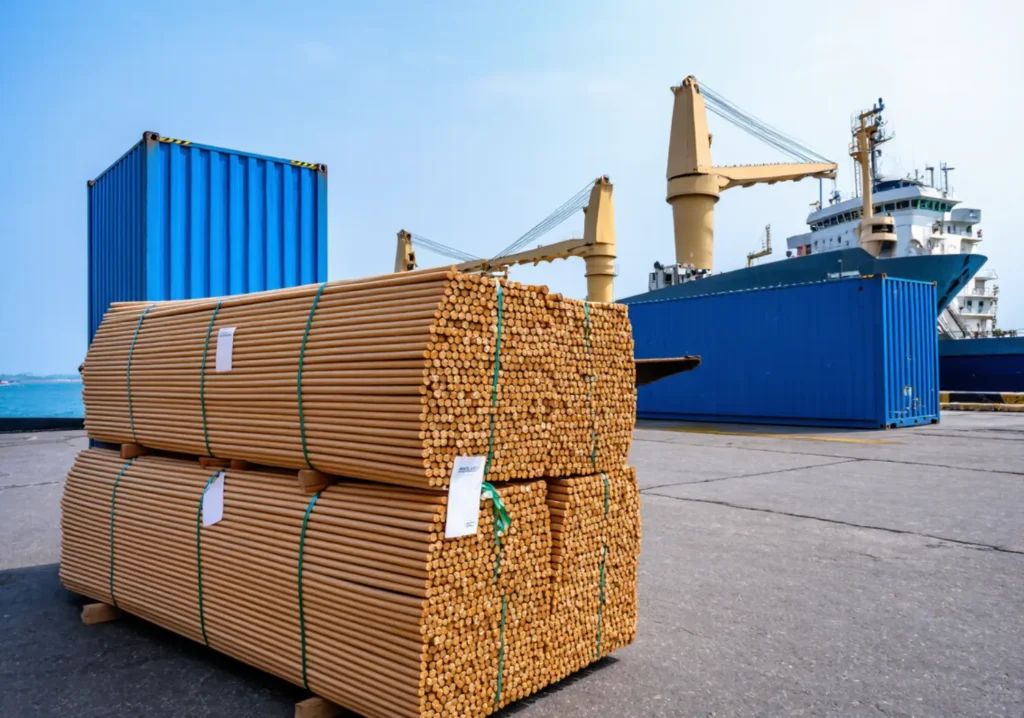Hey there! Are you wondering how to transport rattan materials without them arriving damaged or moldy? You’re in the right place. I’m here to guide you through every step of the process. Whether you’re shipping natural rattan or its plastic counterpart, this article will show you how to get it done right. Plus, I’ll share some insider tips to keep your rattan in top shape and your customers happy.
Let’s start with the most valuable info upfront. Here’s a quick table of key tips to ensure your rattan materials arrive safely:
| Top 5 Tips for Transporting Rattan Materials | Why It Matters |
|---|---|
| Use breathable packaging like woven bags or cardboard | Prevents mold by allowing air circulation |
| Measure packages accurately before shipping | Helps you pick the best transport method |
| Choose sea transport for large, cost-effective loads | Saves money on bulk shipments |
| Keep rattan dry with desiccants or dry containers | Protects against moisture damage |
| Inspect and store properly upon arrival | Ensures quality stays intact |
Now, ready to dive deeper? Let’s explore how you can transport rattan materials like a pro.
Introduction
Have you ever opened a shipment of rattan only to find it warped or covered in mold? It’s frustrating, right? Rattan is a fantastic material—strong, flexible, and perfect for furniture, baskets, and decor. But here’s the catch: transporting rattan materials requires extra care. Natural rattan, harvested from palm plants, is sensitive to moisture and pressure. Plastic rattan, while tougher and waterproof, still needs protection from scratches or dents.
So, why does this matter to you? Proper transportation keeps your rattan in great condition, saves you money on replacements, and keeps your customers satisfied. In this guide, you’ll learn how to prepare, ship, and handle rattan materials effectively. Let’s get started!
Preparation Before Transporting Rattan Materials
Before you ship your rattan, preparation is everything. Think of it as setting the foundation for a smooth journey. Here’s how you can nail it.
Sorting and Packaging
First, sort your rattan products. Are you dealing with cane webbing, rattan core, or rattan peel? Each type has its own needs. For instance, natural rattan hates moisture, so store it in a dry spot before packing.
Next, let’s talk packaging. Avoid plastic wrap—it traps moisture and invites mold. Instead, use breathable materials like woven bags or cardboard boxes. These let air flow and keep your rattan happy. To go the extra mile, toss in some desiccants (those little moisture-absorbing packets). They’re a cheap fix to prevent moldy surprises.
Quick Tip: Shipping plastic rattan? You can skip the moisture worries, but still pack it snugly to avoid scratches.
Measurement and Load Planning
Now, grab a tape measure. You need to know the exact size and weight of your packages. Why? Because this info helps you pick the right transportation method. For example:
- Small shipments (like a few rolls of rattan webbing) might fit nicely in a truck or plane.
- Large loads (think pallets of rattan furniture) are better off on a ship.
By measuring ahead, you’ll avoid overpaying or choosing a method that doesn’t suit your needs. Plus, it makes load planning easier—no guesswork required!
Choosing the Right Transportation Method
So, how do you get your rattan from point A to point B? You’ve got three main options: road, sea, and air. Each has its perks, so let’s break them down to help you decide.
Road Transport
Road transport is your go-to for short trips. It’s fast and straightforward—perfect if you’re shipping locally or regionally. But here’s a heads-up: watch how you load the truck. Don’t stack heavy items on top of your rattan, or you’ll risk crushing it.
When to Use Road Transport:
- Short distances (e.g., within your state or country).
- Smaller shipments that need quick delivery.
Pro Tip: Secure your rattan with straps or padding to keep it steady during bumpy rides.
Sea Transport
Got a big order heading overseas? Sea transport is your best bet. It’s cost-effective for large volumes, like a container full of rattan chairs. However, there’s a catch—moisture. Ships can be damp places, so use dry containers and double-check your packaging. Those desiccants? They’re your best friends here.
When to Use Sea Transport:
- Large quantities (think bulk orders).
- When cost matters more than speed.
Example: Imagine you’re sending 500 rattan tables to Europe. Sea transport saves you cash, but without proper packing, you might open the container to a moldy mess. Don’t let that happen—pack smart!
Air Transport
Need your rattan fast? Air transport is the answer. It’s ideal for urgent orders or high-value items, like custom rattan decor. The downside? It’s pricey. So, weigh the urgency against your budget.
When to Use Air Transport:
- Tight deadlines (e.g., a client needs it ASAP).
- Small, valuable shipments.
Example: Say you’re rushing a batch of premium rattan to a trade show. Air transport gets it there in days, not weeks—worth the cost if time’s tight.
Key Considerations During Transportation
Your rattan’s on the move—great! But don’t relax just yet. Here are some must-know considerations to keep it safe en route.
Humidity Control
Humidity is natural rattan’s worst enemy. Too much moisture, and you’ve got mold or rot on your hands. To fight back:
- Use desiccants in every package.
- Opt for breathable waterproof bags with air holes if extra protection is needed.
Plastic rattan? You’re in luck—it’s waterproof and mold-proof. Still, keep it covered to avoid other damage.
Did You Know? Logistics experts say humidity control is the top way to prevent rattan damage. A small step like adding desiccants can save you big headaches.
Preventing Collision and Deformation
Rattan doesn’t like being squished. To protect it:
- Add fillers like foam, paper, or even bubble wrap (fine for plastic rattan).
- Pack items tightly so they don’t shift and bang into each other.
Natural rattan is delicate, so it needs more cushioning. Plastic rattan is tougher, but why risk dents or scratches?
Managing Transportation Time
Time matters in shipping. Delays can mess up your schedule and upset clients. So, choose a reliable logistics partner. Look for someone with a solid track record—bonus points if they know rattan.
For example, companies like BanSar have over 20 years of experience moving rattan and other goods. They offer sea, air, and rail options, so you’re covered no matter the shipment size. A good partner keeps your rattan on time and stress off your plate.
Extra Tip: Track your shipment. Knowing where it is gives you peace of mind and helps you plan ahead.
Handling After Arrival
Your rattan’s arrived—awesome! But hold off on celebrating. You’ve got a couple of steps to wrap things up.
- Check Everything: Count the items and inspect for damage. Look for mold, cracks, or dents. If something’s off, report it right away.
- Store It Right: Move your rattan to a dry, ventilated spot. Skip the sunny corners—direct sunlight can dry it out and make it brittle.
Quick Fix: Spot some moisture? Let the rattan air dry in the shade before storing or using it. Problem solved!
Conclusion
Transporting rattan materials doesn’t have to be a nightmare. With smart preparation, the right transportation choice, and careful handling, you can keep your rattan in pristine condition. Whether it’s natural or plastic, a little effort goes a long way. Imagine the relief of opening a shipment and seeing everything just as you expected—no damage, no fuss.
Need a hand with logistics? Check out BanSar. With decades of experience, they’re pros at transporting rattan materials via sea, air, or rail. Ready to ship with confidence? You’ve got this!
FAQ
Still have questions? Here are quick answers to common concerns:
- How do I stop rattan from molding during transport?
Use breathable packaging and add desiccants to soak up moisture. - What’s the best way to transport rattan materials?
It depends! Sea transport works for big, budget-friendly loads. Air transport is faster but costs more. - Is plastic rattan easier to ship than natural rattan?
Yes, it’s waterproof and more durable. But natural rattan’s charm might be worth the extra care.
Final Thoughts
There you have it—a full rundown on how to transport rattan materials like a champ. From sorting and packing to picking the perfect shipping method, you’re now equipped to handle it all. Have you tried any of these tips before? Or maybe you’ve got a rattan shipping story to share? Either way, you’re ready to make your next shipment a success. Happy transporting!



